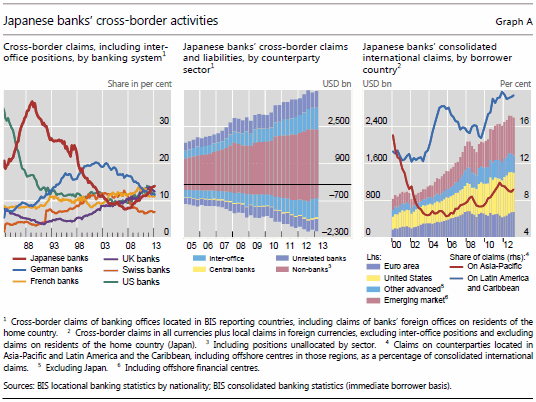The return of Japanese banks
(Extract from pages 16-17 of BIS Quarterly Review, September 2013)
Japanese banks have recently become once again the biggest suppliers of cross-border bank credit. The BIS consolidated banking statistics show that in 2011 Japanese banks replaced German banks as the world's largest international lenders. Japanese banks' share in the consolidated international claims of all BIS reporting banks rose from 8% in early 2007, prior to the start of the global financial crisis, to 13% at end-March 2013. On a consolidated basis, US banks were the next largest cross-border lenders, with a market share of about 12% at end-March 2013, followed by German banks at 11%.1
This marks a return of Japanese banks to the position that they held in the international banking market in the second half of the 1980s. According to the locational banking statistics, which include inter-office activity, Japanese banks' share of the cross-border claims of all BIS reporting banks peaked at no less than 36% in 1989 (Graph A, left-hand panel).2 At that time, Japanese banks funded loans to borrowers in Japan through their overseas offices in order to avoid regulatory restrictions at home.3 They also provided a major share of commercial and industrial loans to US and emerging market borrowers, especially in Asia.4 But the severe banking crisis of the 1990s, in combination with banking deregulation at home, reversed Japanese banks' cross-border expansion sharply. Their market share reached a low in 2007 before rebounding.
The recent international expansion of Japanese banks reflects higher lending to offshore financial centres, emerging market economies and the United States (Graph A, right-hand panel). The increase in cross-border claims on offshore centres was driven mainly by claims on centres in the Caribbean, while Asia and Latin America were the main recipients of the increased credit to emerging market economies. As a result, Japanese banks' claims on borrowers in Latin America and the Caribbean increased to almost 20% of their consolidated international claims at end-March 2013, from 15% in late 2009 (Graph A, right-hand panel). In contrast, the share of claims on advanced economies fell from a high of 74% in late 2009 to 68% most recently. This was mainly driven by a retreat from the euro area, although Japanese banks' consolidated international claims on this region have been picking up gradually since the second quarter of 2012.
The locational statistics show that Japanese banks funded their cross-border expansion mainly through financing raised in Japan. While their cross-border claims increased to $4 trillion in the first quarter of 2013, their cross-border funding was only $2 trillion (Graph A, centre panel). The result is a cross-border funding gap of $2 trillion, which needs to be covered by domestic sources, notably through their large deposit base.5 Of the funding that Japanese banks raise from cross-border sources, the largest part is borrowed from non-banks.
The increase in cross-border lending by Japanese banks was accomplished partly through greater use of their global office network. These banks had closed or downsized many of their foreign offices in the wake of the banking crisis of the 1990s and conducted cross-border business increasingly from Japan. In fact, the share of cross-border claims booked in Japan in the total cross-border claims of Japanese banks reached its highest level in 2008, but since then has gradually declined. This development has been mirrored in a marked increase in cross-border claims booked by Japanese banks in their offices in the United States and other advanced economies.
1 These figures exclude local claims in local currencies, ie credit extended by banks' affiliates located in the same country as the borrower.If local claims are included, then on the basis of consolidated foreign claims the market share of Japanese banks equalled 10% at end-March 2013, compared to 13% for UK banks, 11% for US banks and 9% for German banks.
2 The consolidated statistics are not available on acomparable basis for the 1980s because prior to 1999 they excluded claims on BIS reporting countries.
3 H Terrell, R Dohner and B Lowrey, "The United States and United Kingdom activities of Japanese banks, 1980-1988", North American Review of Economics & Finance, no 1(1), 1990, pp 53-73; A van Rixtel, Informality and monetary policy in Japan: the political economy of bank performance, Cambridge University Press, 2002.
4 R McCauley and R Seth, "Foreign bank credit to US corporations: the implications of offshore loans", Federal Reserve Bank of New York Quarterly Review, Spring 1992, pp 52-65; R McCauley and S Yeaple, "How lower Japanese asset prices affect Pacific financial markets", Federal Reserve Bank of New York Quarterly Review, Spring 1994, pp 19-33.
5 Purely domestic positions will be captured in future as part of the enhancements to the BIS international banking statistics.


